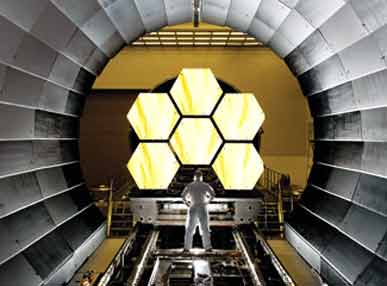Market Report: Federal R&D Funding Fuels Aerospace Growth
November 2011

"While the overall growth rate has slowed in recent years due to global economic turmoil, U.S. aerospace sales have sustained remarkable growth since 2003," wrote William A. Chadwick, Jr., director of the AIA's Aerospace Research Center and lead author for its 2011 Industry Report. "Final numbers for the year also reflect the resiliency of the industry. Reversing a two-year decline, the aerospace industry booked $202.5 billion in orders in 2010, a 23.8 percent increase over 2009."
Much of this growth was supported by federal R&D funding, reflecting the heavy demands from military operations around the world.
Aerospace is one of the most important sectors in the American economy for the jobs it supports (almost 1.2 million nationally), its contribution to the national GDP, and its importance in establishing America's reputation as a leader in science and technology.
"Innovation is at the heart of the aerospace industry," added Chadwick. "The United States continues to lead the world in absolute R&D spending, and within the United States, R&D is expected to grow by 2.4 percent in 2011 to $405.3 billion."
Around the world the demand for civil aircraft is increasing and existing fleets are aging, creating new opportunities for expansion. Industry analysts predict additions to commercial fleets over the next 20 years will grow at an annual rate of 3-5 percent for a total of 30,900 aircraft, valued at $3.6 trillion. Major airframe producers also predict a global increase in travel of at least 5 percent per year.
Just north of the border is Canada, the world's fifth-largest aerospace producer, with top clusters in Toronto and Montreal. Canada-based Bombardier, maker of the popular CRJ regional jet, is a global leader in regional and business aircraft.
No industry better represents the close relationship between Canada and the United States than aerospace, which often results in groundbreaking technology, such as the Canadarm for the International Space Shuttle. Advanced research involving both countries continues through research agreements and partnerships.
For example, a recent agreement between Aéro Montréal, the aerospace cluster of Quebec, and Arizona's Aerospace & Defense Research Collaboratory expands the scope of future joint projects (both clusters already enjoy $2 billion in annual aerospace-related trade).
In the United States, every state supports aerospace manufacturing at some level and is eager to attract the high-level business investment and good-paying jobs aerospace provides. According to a 2009 congressional report, about 60 percent of all U.S. aerospace industry jobs are located in six states: California, Washington, Texas, Kansas, Connecticut, and Arizona. Other strong aerospace manufacturing clusters are found in Oklahoma, Florida, Georgia, Ohio, Mississippi, Alabama, and South Carolina.
West/Northwest Region
California leads the nation in aerospace employment with more than 170,000 direct and indirect jobs (about 20 percent of total aerospace jobs nationwide). California aerospace is a $30 billion business that includes aircraft manufacturing, aircraft engines, equipment and parts, missile and space vehicles, and detection and navigation systems.
Every major U.S. aerospace corporation has a significant presence in California, including Lockheed Martin's extensive production facilities in South Bay and Northrop Grumman in El Segundo, which recently completed the first full system flight test for the Global Hawk unmanned aircraft system, which is equipped with a sophisticated radar sensor that provides near real-time imagery in all conditions.
Northrop Grumman has also started testing the sunshield layers that will protect NASA's James Webb Space Telescope, which will eventually replace the Hubble Space Telescope. During this project the research team also discovered innovative design, modeling, manufacturing, and welding technologies that have exciting commercial applications for the private sector.
To the north in Washington State, more than 650 companies comprise the state's aerospace cluster, with Boeing the central player. "One of the key reasons Washington's aerospace cluster has been so effective is that the state is a consistent leader in aerospace R&D," noted Chadwick. "The University of Washington alone has spent $125 million on aerospace-related research since 2006."
Washington employs about 17 percent of all U.S. aerospace workers, including the country's second-highest concentration of aerospace engineers. The Washington Council on Aerospace recruits new business and advises the state on aerospace training, education, and R&D programs.
In 2010 Boeing delivered 462 airplanes to customers around the world. Boeing also announced it will produce the 737 MAX, a new version of the 737. Boeing already has 496 orders for the 737 MAX, an "overwhelming" response, said Boeing Commercial Airplanes President and CEO Jim Albaugh. Several states are competing for the new plant, including Washington.
Southwest Region
In 2009, Arizona's aerospace and defense industry generated about $300 million in tax revenues and employed 39,400 workers; indirectly it supplied 93,800 jobs and had a GSP of $8.8 billion. Arizona's two main aerospace clusters are located in Tucson and Phoenix. Raytheon Missile Systems is the largest aerospace employer in the state; other major firms are Boeing, Honeywell, B/E Aerospace, Universal Avionics Systems Corporation, and Bombardier.
Arizona State University (ASU) is well known for its aerospace training facilities, including high-altitude chambers and full-motion regional jet simulators. ASU has participated in every major NASA planetary science mission since Apollo, a big reason why Arizona received more than $10.8 billion in Department of Defense contracts in 2010.
Among Raytheon Missile Systems' Department of Defense projects is the assignment to develop a "directed infrared countermeasures system" for protecting unmanned aircraft. Operating at the speed of light, this advanced system uses low-watt lasers to confuse the guidance systems of sophisticated missiles and divert them away from aircraft.
Oklahoma has more than 300 aerospace companies that generate more than $12 billion in revenue. "Aerospace is one of our largest industry sectors, with clusters in both Tulsa and Oklahoma City," explained Dave Lopez, secretary of the Oklahoma Department of Commerce. "It's a good fit because we have the infrastructure to serve the industry."
Oklahoma is best known for MRO (maintenance, repair, and overhaul) and engine manufacturing. Tulsa is home to more than 70 aerospace companies; American Airlines MRO Division is the city's largest aerospace employer. Since January 2011, American Airlines, NORDAM Group, Spirit AeroSystems, and BizJet International have hired more than 1,500 workers.
"Right now we're close to 300 employees and plan to hire another 50 to 60 people within the next six months," said BizJet spokesman Brian Barber. The company will also construct a $1.73 million parts warehouse and engineering facility.
Over the past two years, Texas was the only state that added aerospace manufacturing jobs, according to U.S. Bureau of Labor Statistics. The Texas aerospace industry directly employs about 200,000 workers at over 1,600 companies, making it an ideal location for aerospace investment.
Dallas-Ft. Worth is known for the fighter aircraft it produces. Lockheed Martin designs rocket and missile technology, guidance and control systems, and advanced materials and sensors. Other leading companies are Bell Helicopter Textron, Sikorsky Aircraft, Rolls-Royce, and Boeing.
Leading aerospace tenants at the Port San Antonio (PSA) aerospace complex include Pratt & Whitney, BAE Systems, and Standard Aero. Within PSA is Kelly Aviation Center, a joint venture established by Lockheed Martin, General Electric Aviation, and Rolls-Royce for advancing military engine MRO. Several federal agencies have also partnered with Kelly Aviation Center to commercialize new technologies.
Central Region
Almost 20 percent of the U.S. aircraft engine manufacturing industry is located in Ohio, which is eager to increase that share. In 2010 the state launched the Ohio Aerospace and Business Aviation Council, a public/private partnership designed to expand Ohio's aerospace industry.
Cincinnati-Dayton is home to Ohio's key aerospace cluster and well known for making large jet engines and mission-critical parts for NASA. The Cincinnati-Dayton corridor hosts more than 400 aerospace and related support businesses, including aircraft and parts, aircraft engines and engine parts, fabricated metal products, and instruments.
Nearby Wright-Patterson Air Force Base is an international leader in commercializing new military technologies to the private sector. Nearly 10,000 engineers and scientists at the Wright-Patterson Air Force Base give the region one of the nation's greatest concentrations of aerospace engineering expertise. The U.S. Air Force recently selected the base to be the location for the National Center for Military Aerospace Medical Research.
The heart of aerospace in Kansas is Wichita, a manufacturing center for corporate and general aviation aircraft. Major players include Boeing Integrated Defense Systems, Cessna Aircraft, and Spirit AeroSystems, a leading global supplier of commercial airplane assemblies and components.
In September 2011 Spirit announced it would establish a new manufacturing facility in Chanute, Kansas, to support light sub-assembly work on under-wing aircraft components for the Boeing 737. When fully operational, the Chanute plant will employ about 150 workers.
Valent Aerostructures, another manufacturer of structural components and major sub-assemblies in Kansas, will expand its operations in Fredonia by building a 50,000-square-foot plant.
Northeast Region & North of the Border
Connecticut has nearly 250 aerospace companies with 40,000 employees statewide, including United Technologies Corporation and its subsidiaries Sikorsky, Pratt & Whitney, and Hamilton Sundstrand. Nearly $7 billion of Connecticut's 2010 GSP came from aerospace, equaling about 5 percent of the state's total productivity.
The state is well known for its research, design, and production of jet engines and helicopters. The state's leading companies are supported by an extensive chain of aerospace suppliers and service providers.
To assure the state is competitive, the Connecticut Center for Advanced Technology (CCAT) tracks the industry and identifies emerging opportunities. "We are committed to serving Connecticut aerospace manufacturers through initiatives that help to strengthen our aerospace industrial base and work force," commented Elliot Ginsberg, president of CCAT. Moving north of the border, Montreal is Canada's largest aerospace cluster, accounting for nearly three-quarters of the country's R&D. Over 42,000 employees work for leading firms such as Bombardier Aerospace, Pratt & Whitney Canada, and Rolls-Royce Canada. Bell Helicopter Textron, headquartered in Montreal, is the world's leading producer of rotary wing aircraft.
Montreal is also the site of more than 10 aerospace research centers, including the Canadian Space Agency. It is also home to the headquarters for the International Air Transport Association (IATA) and the International Business Aviation Council (IBAC). French aeronautics group LATECOERE recently decided to establish a Canadian subsidiary in Montreal. "We have some very ambitious development objectives for North American markets," said Hervé Schembri, president of LATecis, a subsidiary of LATECOERE. "We foresee exciting opportunities for engineering design and supplying turnkey systems such as assembly line tools and test benches for the industry."
Project Announcements
Mantis Space Plans Albuquerque, New Mexico, Headquarters-Manufacturing Operations
12/17/2025
JGA Space and Defense Expands Huntersville, North Carolina, Operations
12/05/2025
France-Based Satys Establishes Melbourne, Florida, Operations
12/05/2025
GE Aerospace Expands West Jefferson, North Carolina, Jet Engine Assembly Operations
11/26/2025
Castelion Plans Sandoval County, New Mexico, Rocket Motor Manufacturing Operations
11/18/2025
Elbit Systems of America Expands Roanoke County, Virginia, Manufacturing Operations
11/15/2025
Most Read
-
The Workforce Bottleneck in America’s Manufacturing Revival
Q4 2025
-
Rethinking Local Governments Through Consolidation and Choice
Q3 2025
-
Lead with Facts, Land the Deal
Q3 2025
-
Investors Seek Shelter in Food-Focused Real Estate
Q3 2025
-
Tariff Shockwaves Hit the Industrial Sector
Q4 2025
-
America’s Aerospace Reboot
Q3 2025
-
The Permit Puzzle and the Path to Groundbreaking
Q3 2025



